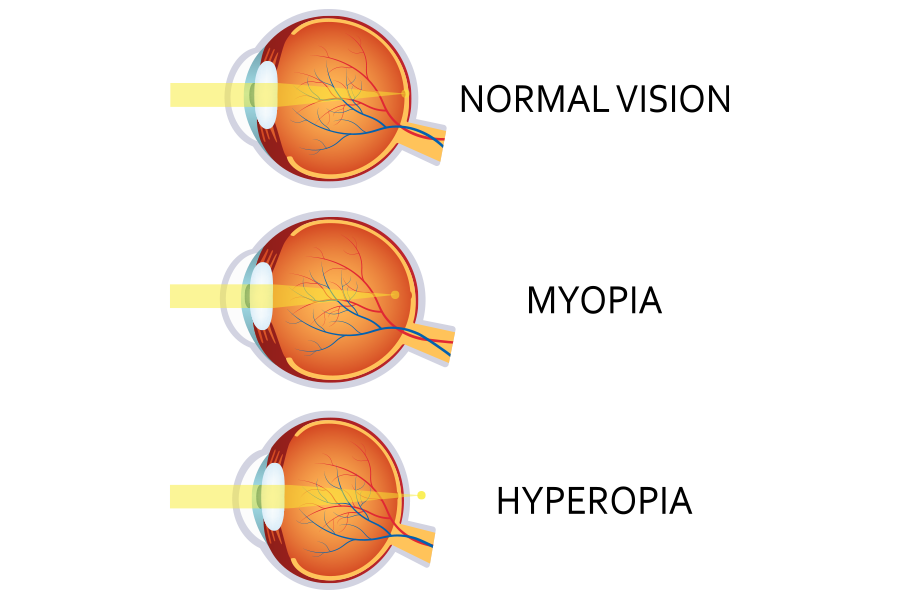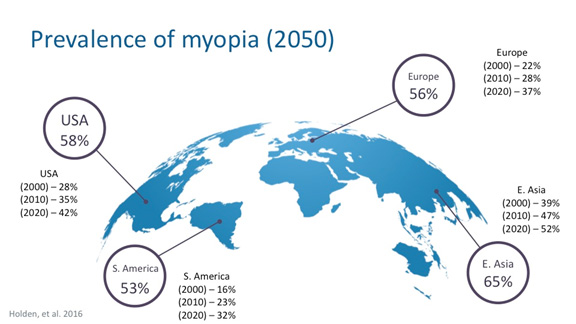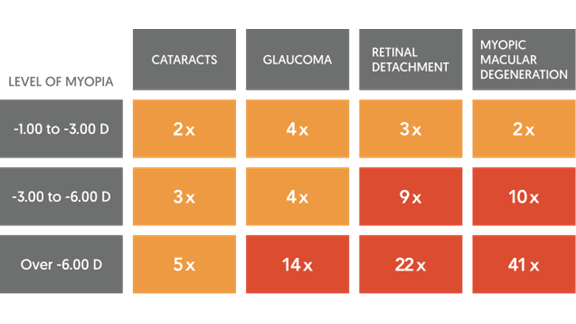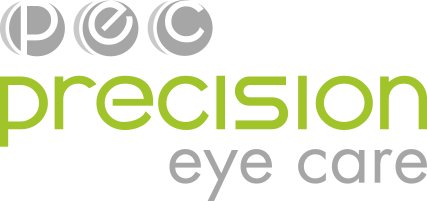Myopia Management
The “Other” Global Pandemic
Myopia, commonly known as nearsightedness or shortsightedness, is a condition that most being are familiar with.
Myopia is where it causes objects to be blurry in the distance but clearer when closer to your eye. This is where your child may have been moved to the front of the classroom because he/she could not see the smart board.
For many years, having myopia and being nearsighted was a “normal” condition, however research is suggesting that it can pose a significant risk to your child’s long term eye health and vision.
What is Myopia?
Myopia is more than just “blurry vision”. Myopia develops when the eyeball grows too long from front to back. Functionally, when light enters the eye, the rays of light focuses in front of the retina because of the excessive light. The growth of the eyeball starts in childhood and we typically see a drastic increase as the child enters their first decade of life and approaching late teen years.
Myopia can be classified as low, moderate, high, progressive or pathologic and the prevalence and incidence of all forms of myopia are increasing.


The Myopia Epidemic & Pandemic
The prevalence of myopia is increasing at alarming rates not only in certain regions of the world, but worldwide. Myopia rates have increased in the last 20 years with a recent study estimating that close to 40% of the world’s population is currently myopic. By 2050, based on trajectory patterns, close to 50% of the global population will be myopic as reported by the World Health Organization. That’s a staggering 5 billion people!
Why Should We Care?
What many people don’t know is that myopia is dangerous. In research, there is conclusive evidence that shows that myopia significantly increases the risk of significant ocular complications causing potential vision loss for your child as he or she grows into adulthood. Examples of these conditions include earlier onset of cataracts, glaucoma, retinal detachment, and myopic maculopathy.
Myopic maculopathy can arguably be the most harmful ocular complication from a rapidly growing eyeball. The reason for this is the excessive stretching of the retinal tissue as the eye continues to elongate. As the tissue continues to stretch, the retina becomes more fragile as it thins out. In research, the authors deemed myopia as the second largest cause of blindness in the world, second only to cataracts.


Myopia is a huge public health burden in many parts of world, in particular Southeast Asia, and is quickly spreading globally. Unfortunately, trends suggest that it is not slowing down anytime soon and is only getting worse.
What Is Myopia Management?
Myopia management is a specialized discipline of optometry for the purpose of slowing down the progression of myopia in children. It includes the range of services and advanced methods to achieve those results but to also provide the patient with clear, comfortable, efficient binocular vision and good ocular health. Precision Eye Care has the training and experience to offer your child the best-personalized treatment to manage myopia.
Traditional glasses and contact lenses work only to compensate for your child’s blurry vision. They do not address the ocular health concerns associated with myopia as do the other methods have proven to do in the literature.

Myopia Management Starts With You – The Parent(s)
Children are not likely to recognize vision problems and changes, and as their health advocates, the responsibility is on the parents and at times, secondary caregivers such as teachers to observe certain signs or to simply maintain routine eye examination visits to their family optometrist.
As such, regular comprehensive eye exams for your child yearly, in the province of Alberta, is extremely important to ensure your child’s vision is developing within a normal range for their stage of development. With any general health condition, early detection and intervention is the key for initiating proper treatment in a timely manner.
Myopia Management
Treatment
FAQs
What Causes Myopia?
Myopia has multi-factorial causes with both nature and nurture contributing. In other words, nature describes the factors we are unable to control but helps with risk analysis for the child. Nurture describes the factors that we do have control over and have a hand in attempting to address them in the child’s everyday life.
Genetics/Family History
Less Time Spent Outdoors
Studies have shown that a deficiency in even just exposure to natural sunlight could contribute to increased prevalence of myopia.
Increased Screen Time
School-aged children who spend 7+ hours per week or more using computers or mobile video games triple their risk for myopia.
Ethnicity
There have been multiple studies that looked at this particular variation. Looking at them collectively, ethnicity does appear to be a strong predictor for myopia with the East/Southeast and South Asian children having higher myopia and their myopia progressing faster compared to the white children.
Frequently Asked Questions
1. Why haven’t I heard of this before?
- Myopia management is well known in certain regions of the world where the prevalence of myopia is significantly higher
- North America is starting to show signs of the same trends over the last decade or so
- Recent research and clinical studies have continued to show strong support that myopia in children can be slowed
- There is a lot of work in North America to spread awareness and to educate both the public and other eye care professionals in this discipline
2. What does the consultation look like?
- Precision Eye Care will typically start with a virtual conference call. We understand that prior to having a battery of tests done, you may have many questions around what myopia management is.
- This is followed by scheduling an in-office appointment for a myopia management work up. This involves a review of your child’s history, specialized testing, detailed discussion about your child’s findings, and a conversation around the recommended treatment plan.
- We typically budget about one hour of time for the initial consultation.
3. Are these treatments safe for my child?
- All treatment options we offer for your child are ones we would use for our own children and family members.
- All modes of treatment have years and even decades of scientific research on its effective and safety profile for children
- With all general medical procedures, there will always be risks associated with active use. Precision Eye Care will address them and have a discussion around proper follow up care to ensure excellent ocular health through the duration of the treatment.
4. What is the success rate for my child?
- As with anything, we cannot 100% guarantee the same success rate as we don’t have a crystal ball to look into the future
- Our best estimation for your child is based on the results shown in clinical studies
- Precision Eye Care will discuss expectations for your child’s specific case at your initial consultation
5. Outside from myopia management treatment options, is there anything else my child can do?
- Yes! Behaviour and lifestyle habits have a significant role when it comes to myopia management
- Some helpful tips include:
- Increasing time outdoors (2-3 hours a day)
- Use UV protection when outdoors
- Keep digital devices at arm’s length
- Visual hygiene using the 20/20/20 rule – Every 20 minutes, take 20 seconds to look at something 20 feet away
- Good lighting when doing any activity – natural light is very hepful
